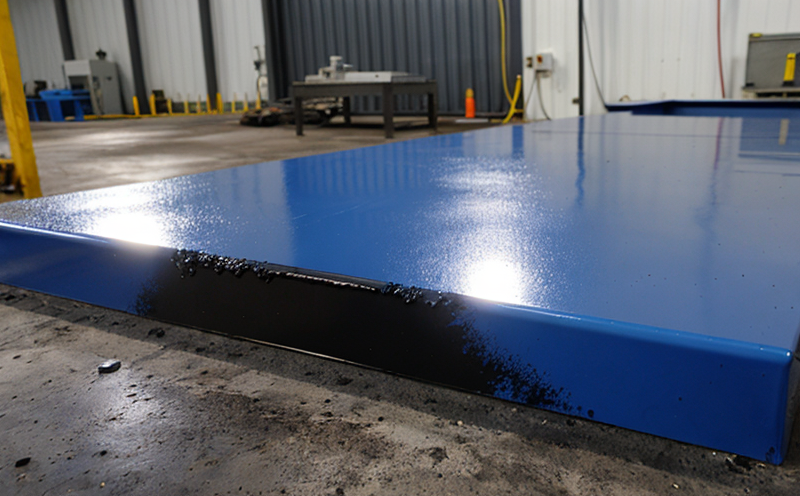ASTM G154 UV Exposure Resistance Testing of Coatings
The ASTM G154 standard is a critical tool in assessing the resistance of surface coatings to ultraviolet (UV) radiation. This method evaluates how well a coating can withstand the harsh environment that typically leads to degradation, ensuring its durability and performance over extended periods.
Surface coatings play a pivotal role across numerous industries including automotive, aerospace, construction, and electronics, where exposure to UV light is a significant concern. The primary goal of this testing is to ensure that coatings maintain their integrity and provide the expected level of protection against environmental factors such as sunlight and moisture.
The ASTM G154 standard specifies a combination of xenon-arc lamps with filtered UV radiation (295–365 nm) to simulate solar radiation. This method helps in predicting the long-term weathering resistance of coatings by mimicking the effects of natural outdoor exposure, including ultraviolet light, rain, and humidity.
The testing process is designed to be highly reproducible, ensuring consistent results across different laboratories. Specimens are exposed to UV radiation for a specific duration, typically 1000 hours or more, depending on the required level of aging. This allows for the evaluation of changes in color, gloss, and adhesion over time.
Understanding the implications of this testing is crucial for quality managers and compliance officers who need to ensure that their products meet stringent standards. R&D engineers can leverage these results to refine formulations and improve product longevity, while procurement professionals benefit from knowing which suppliers deliver high-quality materials that withstand environmental stressors effectively.
The ASTM G154 test provides a valuable tool for ensuring the reliability of surface coatings across various industries. By simulating real-world conditions in a controlled environment, it helps manufacturers make informed decisions about product development and quality assurance.
Scope and Methodology
| Aspect | Description |
|---|---|
| Samples | Typically, flat or cylindrical specimens of the coating to be tested are required. The samples should represent real-world conditions as closely as possible. |
| Lamp Type | Xenon-arc lamps with filters that pass only UV radiation (295–365 nm) are used to simulate solar UV radiation. |
| Test Duration | The standard test duration is 1000 hours, but this can be adjusted based on the specific requirements of the material being tested. |
| Environmental Conditions | In addition to UV exposure, the specimens are also subjected to a controlled humidity and temperature environment during the testing period. |
| Data Collection | Regular measurements of color, gloss, adhesion, and other relevant properties are taken throughout the test duration. |
This table outlines key aspects of the ASTM G154 methodology. The use of xenon-arc lamps with specific UV filters ensures that the testing closely mimics natural solar radiation. The controlled environmental conditions, including humidity and temperature, further enhance the accuracy of the test results.
Regular monitoring allows for detailed data collection which can be used to assess changes in coating performance over time. This comprehensive approach helps in identifying any potential weaknesses or areas where improvements are needed. It is essential for industries that rely heavily on surface coatings for durability and protection against environmental factors.
Customer Impact and Satisfaction
- Enhanced Product Reliability: By ensuring that coatings resist UV degradation, manufacturers can extend the lifespan of their products, leading to greater customer satisfaction. Consumers are more likely to trust brands that offer durable products.
- Compliance with Standards: Meeting ASTM G154 standards ensures compliance with international regulations and industry best practices, reducing legal risks for businesses.
- Prediction of Long-Term Performance: The test provides insights into how coatings will perform in real-world conditions, helping manufacturers make informed decisions about product development.
- Sustainability: Coatings that withstand UV exposure contribute to sustainable practices by reducing the need for frequent replacement and maintenance. This is particularly beneficial in industries where environmental impact is a key concern.
The benefits of ASTM G154 testing extend beyond just compliance; it also enhances the reputation of manufacturers who prioritize product quality and durability. Satisfied customers are more likely to recommend products, leading to increased market share and brand loyalty.
For procurement professionals, selecting suppliers that adhere to such rigorous testing standards ensures they receive high-quality materials capable of withstanding environmental stresses. This aligns perfectly with the goals of sustainability and long-term product reliability.
International Acceptance and Recognition
The ASTM G154 UV Exposure Resistance Testing method is widely recognized and accepted in various industries globally. It is particularly valued by organizations that need to ensure their products meet stringent quality and performance standards.
Many international standards bodies, including ISO, EN, and IEC, reference ASTM G154 as a best practice for evaluating the UV resistance of coatings. This recognition underscores its importance in ensuring consistent and reliable results across different regions and industries.
The method's broad acceptance is due to its ability to simulate real-world conditions accurately while providing reproducible results. This makes it an invaluable tool for manufacturers, researchers, and quality assurance professionals worldwide.
By adhering to ASTM G154 standards, businesses can demonstrate their commitment to quality and excellence in product development. This not only enhances their reputation but also helps them stay competitive in a global market.





